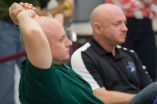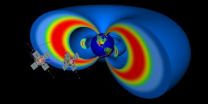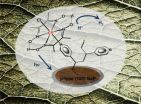Richard Obedian, M.D. To Mentor Young Surgeons
2014-03-08
Richard Obedian, M.D., is one of the to orthopedic surgeons in the State of New York. He is sought after as a presenter on medical topics, is widely published in medical journals, and practices at Island Spine and Sports in Hicksville, New York, where he serves as Director.
But Richard Obedian, M.D., is at the stage of his career where he is prepared to start giving back. Like most successful professionals, Richard Obedian, M.D. says he could not have had the success he has had without a lot of help along the way. Richard Obedian, M.D. says several great coaches and ...
NASA Launches New Research, Seeks the Subtle in Parallel Ways
2014-03-08
On March 7, NASA announced the selection of 10 investigations for the study of identical twin astronauts Scott and Mark Kelly and, in doing so, launched human space life science research into a new era. Although NASA's Human Research Program has been researching the effects of spaceflight on the human body for decades, these 10 investigations will provide NASA with broader insight into the subtle effects and changes that may occur in spaceflight as compared to Earth-based environments. NASA and the National Space Biomedical Research Institute (NSBRI) will jointly manage ...
Education 'protects' poor women from fattening effects of rising wealth
2014-03-08
Obesity levels among women in low- and middle-income countries tend to rise in line with wealth as they purchase more energy-dense foods, but a new UCL study suggests that more educated consumers make better food choices that mitigate this effect.
The study showed that in middle-income countries, obesity levels among women with secondary or higher education are 14-19% lower than less-educated women of similar wealth.
The research, published in PLOS ONE, looked at the relationships between obesity, education and wealth in over 250,000 people across four middle-income ...
Deer proliferation disrupts a forest's natural growth
2014-03-08
ITHACA, N.Y. – By literally looking below the surface and digging up the dirt, Cornell researchers have discovered that a burgeoning deer population forever alters the progression of a forest's natural future by creating environmental havoc in the soil and disrupting the soil's natural seed banks.
The study, "Deer Browsing Delays Succession by Altering Aboveground Vegetation and Belowground Seed Banks," was published online March 7 in PLOS ONE.
"Deer are slowing down forest succession or natural establishment. In fact, the deer are preventing forests from establishing," ...
New guidelines employ a team approach to autism diagnosis and care
2014-03-08
Improving diagnosis and treatment for individuals with autism has been the focus of a growing body of research. New information from these studies led the American Academy of Child and Adolescent Psychiatry to revise key parameters for evaluating and treating autism. Researchers led by Yale Child Study Center director Fred Volkmar, M.D., have published the new practice parameters in the Feb. issue of the Journal of the American Academy of Child and Adolescent Psychiatry.
"Early diagnosis of children with autism spectrum disorders means treatments will be introduced that ...
Research on 3D scaffolds sets new bar in lung regeneration
2014-03-07
In end-stage lung disease, transplantation is sometimes the only viable therapeutic option, but organ availability is limited and rejection presents an additional challenge. Innovative research efforts in the field of tissue regeneration, including pioneering discoveries by University of Vermont (UVM) Professor of Medicine Daniel Weiss, M.D., Ph.D., and colleagues, holds promise for this population, which includes an estimated 12.7 million people with chronic obstructive pulmonary disorder (COPD), the third leading cause of death in the U.S.
In the past year alone, Weiss ...
New NASA Van Allen Probes observations helping to improve space weather models
2014-03-07
Using data from NASA's Van Allen Probes, researchers have tested and improved a model to help forecast what's happening in the radiation environment of near-Earth space -- a place seething with fast-moving particles and a space weather system that varies in response to incoming energy and particles from the sun.
When events in the two giant doughnuts of radiation around Earth – called the Van Allen radiation belts -- cause the belts to swell and electrons to accelerate to 99 percent the speed of light, nearby satellites can feel the effects. Scientists ultimately want ...
NASA satellites see double tropical trouble for Queensland, Australia
2014-03-07
There are two developing areas of tropical low pressure that lie east and west of Queensland, Australia. System 96P and System 98P, respectively. The MODIS instrument that flies aboard both NASA's Aqua and Terra satellites captured images of both tropical trouble-makers as each satellite passed overhead on March 7.
In the Coral Sea, part of the Southwestern Pacific Ocean, System 96P was just 125 nautical miles/143.8 miles/231.5 km north-northeast of Willis Island, Australia. It was centered near 14.3 south latitude and 150.6 east longitude. System 96P is moving in south-southwesterly ...
The dark side of fair play
2014-03-07
We often think of playing fair as an altruistic behavior. We're sacrificing our own potential gain to give others what they deserve. What could be more selfless than that? But new research from Northeastern University assistant professor of philosophy Rory Smead suggests another, darker origin behind the kindly act of fairness.
Smead studies spite. It's a conundrum that evolutionary biologists and behavioral philosophers have been mulling over for decades, and it's still relatively unclear why the seemingly pointless behavior sticks around. Technically ...
Service is key to winery sales
2014-03-07
ITHACA, N.Y. – To buy, or not to buy? That is the question for the more than 5 million annual visitors to New York's wineries. Cornell University researchers found that customer service is the most important factor in boosting tasting room sales, but sensory descriptions of what flavors consumers might detect were a turn-off.
The findings stem from two studies on how the tasting room experience affects customer purchases and what wineries can do to create satisfied sippers, published in the current issue of the International Journal of Wine Business Research.
"On average, ...
Ever-so-slight delay improves decision-making accuracy
2014-03-07
NEW YORK, NY (March 7, 2014) — Columbia University Medical Center (CUMC) researchers have found that decision-making accuracy can be improved by postponing the onset of a decision by a mere fraction of a second. The results could further our understanding of neuropsychiatric conditions characterized by abnormalities in cognitive function and lead to new training strategies to improve decision-making in high-stake environments. The study was published in the March 5 online issue of the journal PLoS One.
"Decision making isn't always easy, and sometimes we make errors ...
Notre Dame chemists discover new class of antibiotics
2014-03-07
A team of University of Notre Dame researchers led by Mayland Chang and Shahriar Mobashery have discovered a new class of antibiotics to fight bacteria such as methicillin-resistant Staphylococcus aureus (MRSA) and other drug-resistant bacteria that threaten public health. Their research is published in the Journal of the American Chemical Society in an article titled "Discovery of a New Class of Non-beta-lactam Inhibitors of Penicillin-Binding Proteins with Gram-Positive Antibacterial Activity."
The new class, called oxadiazoles, was discovered in silico (by computer) ...
New theory on cause of endometriosis
2014-03-07
Changes to two previously unstudied genes are the centerpiece of a new theory regarding the cause and development of endometriosis, a chronic and painful disease affecting 1 in 10 women.
The discovery by Northwestern Medicine scientists suggests epigenetic modification, a process that enhances or disrupts how DNA is read, is an integral component of the disease and its progression. Matthew Dyson, research assistant professor of obstetrics and gynecology at Northwestern University Feinberg School of Medicine and and Serdar Bulun, MD, chair of obstetrics and gynecology ...
Bone turnover markers predict prostate cancer outcomes
2014-03-07
(SACRAMENTO, Calif.) —Biomarkers for bone formation and resorption predict outcomes for men with castration-resistant prostate cancer, a team of researchers from UC Davis and their collaborators have found. Their study, published online in the Journal of the National Cancer Institute, also found that the markers identified a small group of patients who responded to the investigational drug atrasentan. The markers' predictive ability could help clinicians match treatments with individual patients, track their effectiveness and affect clinical trial design.
Castration-resistant ...
Promising news for solar fuels from Berkeley Lab researchers at JCAP
2014-03-07
There's promising news from the front on efforts to produce fuels through artificial photosynthesis. A new study by Berkeley Lab researchers at the Joint Center for Artificial Photosynthesis (JCAP) shows that nearly 90-percent of the electrons generated by a hybrid material designed to store solar energy in hydrogen are being stored in the target hydrogen molecules.
Gary Moore, a chemist and principal investigator with Berkeley Lab's Physical Biosciences Division, led an efficiency analysis study of a unique photocathode material he and his research group have developed ...
Anti-psychotic medications offer new hope in the battle against glioblastoma
2014-03-07
Researchers at the University of California, San Diego School of Medicine have discovered that FDA-approved anti-psychotic drugs possess tumor-killing activity against the most aggressive form of primary brain cancer, glioblastoma. The finding was published in this week's online edition of Oncotarget.
The team of scientists, led by principal investigator, Clark C. Chen, MD, PhD, vice-chairman, UC San Diego, School of Medicine, division of neurosurgery, used a technology platform called shRNA to test how each gene in the human genome contributed to glioblastoma growth. ...
Agricultural fires across the Indochina landscape
2014-03-07
Agricultural fires are still burning in Indochina ten days after the last NASA web posting about the fires. This natural-color image, taken on March 07, 2014, by the Moderate Resolution Imaging Spectroradiometer, MODIS, aboard the Aqua satellite, shows a more comprehensive area of burning agricultural fires that stretch from Burma through to Laos and south throughout Thailand. Actively burning areas, detected by MODIS's thermal bands, are outlined in red.Fire is used in cropland areas for pest and weed control and to prepare fields for planting. Crop residue burning helps ...
NYU researchers find majority of Latinas are unaware of their risk of diabetes
2014-03-07
Approximately 5.5 million Latinas suffer from elevated fasting plasma glucose (FPG) and nearly 4 million of those women were never told by a healthcare provider they were at risk for diabetes, pre-diabetes, or were borderline for diabetes.
The study, "Latinas with Elevated Fasting Plasma Glucose: An Analysis Using NHANES 2009-2010 Data," led by Dr. Shiela M. Strauss, Associate Professor, New York University College of Nursing (NYUCN), points to the urgent need for alternate sites of opportunity for diabetes screenings. There is also a need for effective and culturally ...
Smartphones become 'eye-phones' with low-cost devices developed by Stanford
2014-03-07
STANFORD, Calif. — Researchers at the Stanford University School of Medicine have developed two inexpensive adapters that enable a smartphone to capture high-quality images of the front and back of the eye. The adapters make it easy for anyone with minimal training to take a picture of the eye and share it securely with other health practitioners or store it in the patient's electronic record.
"Think Instagram for the eye," said one of the developers, assistant professor of ophthalmology Robert Chang, MD.
The researchers see this technology as an opportunity to increase ...
For older drivers, study finds, 1 drink may be 1 too many
2014-03-07
GAINESVILLE, Fla. — You may have only had one glass of wine with dinner, but if you're 55 or older, that single serving may hit you hard enough to make you a dangerous driver.
So, baby boomers, what you suspected is true: you can't party like you used to.
Sara Jo Nixon, Ph.D., a professor in the departments of psychiatry and psychology at the University of Florida and doctoral candidate Alfredo Sklar tested how drinking legally non-intoxicating levels of alcohol affect the driving skills of two age groups: 36 people ages 25 to 35 and 36 people ages 55 to 70. They found ...
Software analyzes apps for malicious behavior
2014-03-07
This news release is available in German.
Last year at the end of July the Russian software company "Doctor Web" detected several malicious apps in the app store "Google Play". Downloaded on a smartphone, the malware installed — without the permission of the user — additional programs which sent expensive text messages to premium services. Although Doctor Web, according to its own statement, informed Google immediately, the malicious apps were still available for download for several days. Doctor Web estimates that in this way up to 25,000 smartphones were used ...
Cells appearing normal may actually be harbingers of lung cancer
2014-03-07
HOUSTON -- Seemingly healthy cells may in fact hide clues that lung cancer will later develop, according to a study led by researchers at The University of Texas MD Anderson Cancer Center The research is published online in the Journal of the National Cancer Institute.
Examination of gene expression in patients with non-small cell lung cancer (NSCLC) showed the area adjacent to tumors is rich with cancer markers. In addition, researchers discovered the previously unknown role of a cancer-promoting gene in the airways of smokers with lung cancer.
"We believe this study ...
Pre-term birth and asthma
2014-03-07
Researchers at Brigham and Women's Hospital (BWH) in Boston, Massachusetts, in collaboration with investigators at the Maastricht University Medical Centre and Maastricht University School of Public Health in the Netherlands and The University of Edinburgh in the United Kingdom, have published findings strongly suggesting that preterm birth (prior to 37 weeks gestation) increases the risk of asthma and wheezing disorders during childhood and that the risk of developing these conditions increases as the degree of prematurity increases.
The findings are based on a systematic ...
Hospital food safety measures reduce risk of contaminated hospital food
2014-03-07
A new study found more than 80 percent of raw chicken used in hospitals in food for patients and staff was contaminated with a form of antibiotic resistant bacteria called extended-spectrum beta-lactamase (ESBL) producing E. coli. While sufficient preparation eliminated the presence of bacteria, poultry meat delivered to hospital kitchens remains a potential point of entry for these dangerous bacteria into the hospital. The study was published in the April issue of Infection Control and Hospital Epidemiology, the journal of the Society for Healthcare Epidemiology of America.
"While ...
Emerging multi-drug resistant infections lack standard definition and treatment
2014-03-07
Infection control practices for detecting and treating patients infected with emerging multidrug-resistant gram-negative bacteria (MDR-GNB) vary significantly between hospitals. A study from the Society for Healthcare Epidemiology of America Research Network, a consortium of more than 200 hospitals collaborating on multi-center research projects, found this inconsistency could be contributing to the increase in multidrug-resistant bacteria. The study is published in the April issue of Infection Control and Hospital Epidemiology.
"Differences in definitions and practices ...
[1] ... [3763]
[3764]
[3765]
[3766]
[3767]
[3768]
[3769]
[3770]
3771
[3772]
[3773]
[3774]
[3775]
[3776]
[3777]
[3778]
[3779]
... [8688]
Press-News.org - Free Press Release Distribution service.







